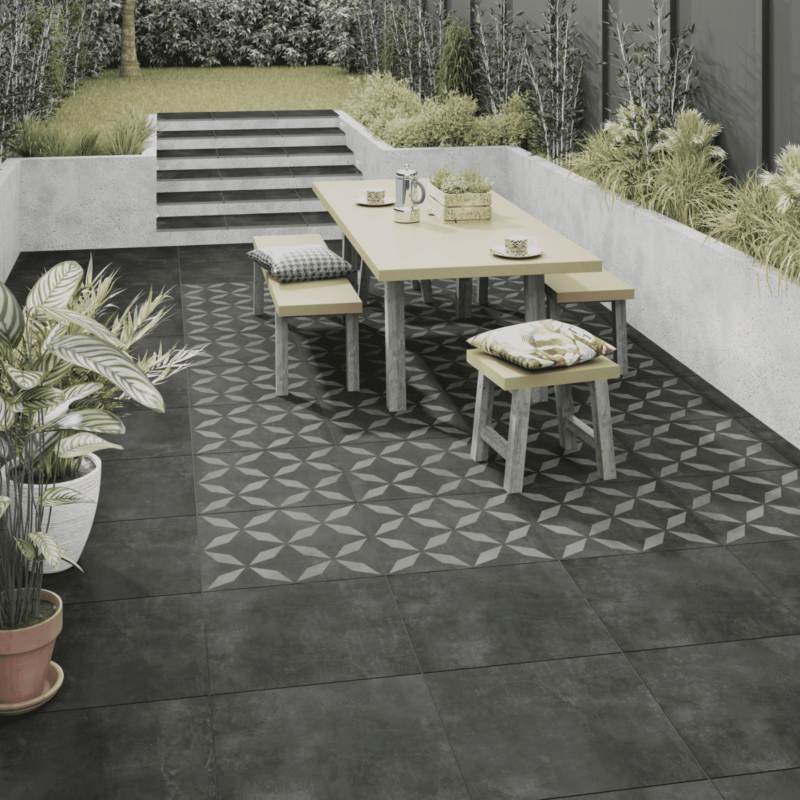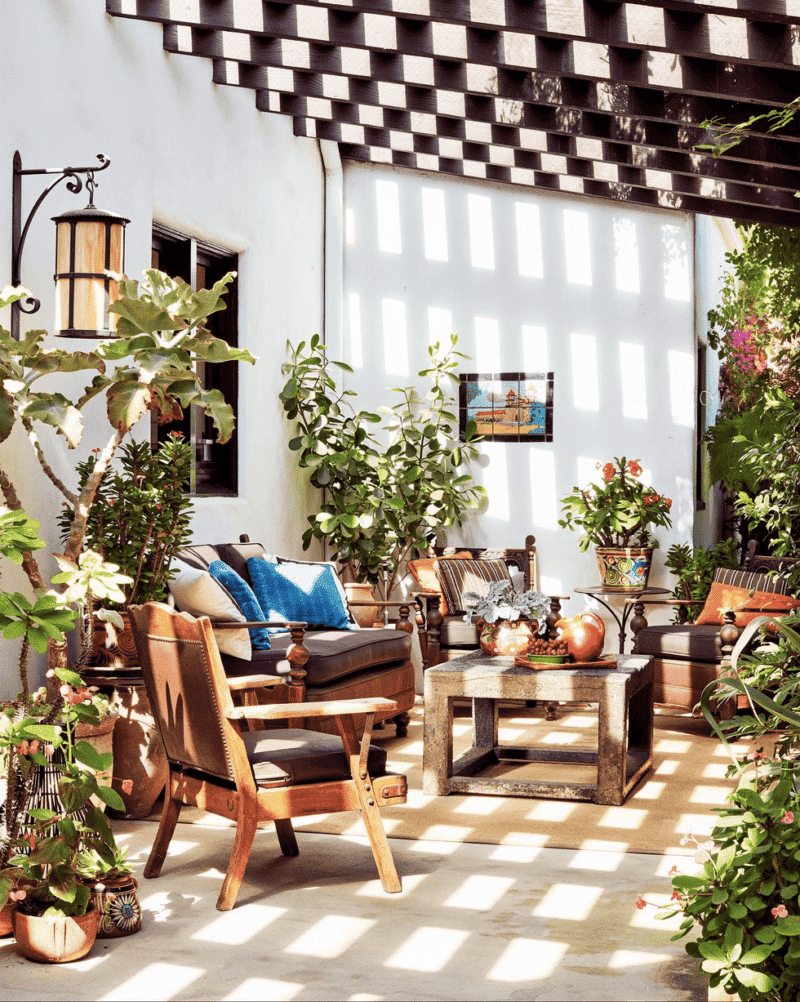Why should you cover up a concrete patio?
Patios are an extremely popular choice for many homeowners—they are durable, functional, easy to clean and maintain, and even easier to install. That said, they can be prone to cracks and dents, especially after being exposed to a couple of years of regular wear & tear and harsh weather elements.
Protecting it from damage is not the only reason why someone might want to cover up their concrete patio. A plain concrete slab, no matter how practical, can get boring over time, which is why many choose to add decorative elements and designs.
It works both ways, too. Sprucing up your concrete patio can inspire you to tackle the rest of your backyard. For those who haven’t gotten around to it yet, here are a couple of ideas that can transform your backyard into a stunning private space your family and guests will love.
How much does covering a concrete patio cost?
It depends on the effect you’re after.
On average, pouring a concrete patio costs approximately $2,800, or about $10/square foot on average, says ConcreteNetwork.com.
The price varies from project to project and mainly depends on the size of the patio, as well as the type and complexity of the cover you choose.
For example, a plain concrete floor with no finishes or colors may cost between $5 and $7 per square foot, while an elaborate design (including borders, hand-painted elements, and saw-cut designs) can go up to $15 per square foot or more.
Who does the work is another crucial factor. Sealants, one of the more traditional ways to cover your concrete patio, will cost you between $1.25 and $1.75 per square foot if you hire a professional. On the other hand, a DIY job would cost between $0.10 and $0.75, according to home services company Angi.
Luckily, you don’t always have to go traditional or pay a small fortune to spruce up your backyard patio.
Take a look at some creative and inexpensive ways to cover your concrete patio and turn it into the talk of the neighborhood.
1. Install pavers over the patio

(source: Angi)
Concrete pavers are the go-to choice for many homeowners looking to cover their concrete patio.
For one, they are incredibly durable. Concrete pavers have a 50+ years lifespan and they are four times stronger than concrete, so they can withstand harsh weather and freeze-thaw conditions. They’re also a lot cheaper than installing pavers directly on the ground—the Family Handyman estimates that you would save 12 tons of sand by placing pavers on concrete instead of gravel.
On top of that, they come in a variety of textures and colors—you can go with a simple running bond pattern or create geometric squares and swirls for a more whimsical look.
Lastly, laying pavers can be a phenomenal outdoor DIY project. You only need basic skills to get the job done to perfection; plus, you would be saving $4 to $11 per square foot off the cost of installation, says Angi.
| Is a patio the same as a terrace? Read more about the difference between terraces, balconies, and patios. |
2. Lay tiles over the concrete

Laying tile over your concrete patio is an easy solution for homeowners who want to give their outdoor area a new, fresh look and cover up dents and cracks at the same time.
Tile flooring is not only durable and easy to maintain, but it is also available in tons of patterns and colors so you get really creative and play around with different designs.
First, though, make sure you choose tiles that are suitable for outdoor use and have a COF of at least 7 (this indicates how slippery tiles are when wet). Porcelain and stone tiles usually meet both criteria.
You also need to ensure that the patio is flat and smooth—you can fill small chips with tile adhesive, but bigger dents and cracks will need to be smoothed out with a self-leveling concrete resurfacer before you can lay the tiles.
3. Install a wooden deck over it

Adding wood to concrete is a fantastic way to protect your patio and add some warmth, instantly transforming a bland concrete slab into a cozy space. You can also complete the look (and further protect the deck) with a stunning modern pergola.
Wooden decks are not cheap—in fact, it costs around $7,000 to install one, according to All-Pro Decks & Patios. However, using decking over an existing concrete patio is more affordable than building a wooden deck from the ground up. Plus, you can cut down on some of the costs by doing it yourself. To reduce expenses even further take a look at some budget-friendly ideas on how to fix up the wooden deck once completed.
You will need some instructions and tools (you can try renting power tools to save money), but overall this is not a complicated job and can even inspire you to get into other woodworking projects.
4. Stamp the concrete

Concrete stamps will give the wow effect of tiles and brick, but at half the price.
The idea is to apply a concrete resurfacer over your old patio and afterward stamp a pattern of your choice—there is a huge selection of patterns and designs available, so the sky’s the limit.
To get started, place a layer of concrete over the slab (this is similar to resurfacing a concrete slab), smooth it to make it level, and then apply the stamps before the concrete sets.
The stamps, made from polyurethane and starting at about $200 per stamp, are the most expensive part of the entire project. You are likely to need more than one, so if buying stamps is out of your budget, look for places that rent concrete stamps at affordable prices.
You can do the work yourself, but if you’re after a more polished texture, you might want to hire a professional.
5. Paint the concrete

Playing with paints and stains is another cost-efficient way to customize your patio.
Painted concrete not only looks gorgeous, but it will coat the concrete as well, protecting it from use and the elements. On top of that, concrete paints are durable (they last for about 5 years) and inexpensive.
There are plenty of options when it comes to outdoor paints, too. Most hardware stores or online shops have dozens of pallets to choose from, so this is your chance to let your creativity run wild. You can color the concrete surface with accent colors, go traditional and stick to one base shade, or mix and match both.
You could even try roll-on textured paint or stencils to create a one-of-a-kind design. Finally, you can get the whole family involved and turn this into a fun weekend activity.
6. Coat with epoxy

Epoxy may not be the cheapest way to cover up a concrete patio, as professional products and installation can be a bit on the higher end of the spectrum. What’s more, not all types of epoxy are safe to be used by DIYers as anything other than water-based epoxy (such as solid and solvent-based epoxies) can give off dangerous fumes.
That said, epoxy can protect your concrete patio and increase its lifespan—Surface Solutions says that epoxy coating applied to outdoor areas can last up to 10 to 20 years (provided you use high-quality products). Also, applying epoxy can give your outdoor area a new shiny look and feel that is hard to achieve with other materials.
Bear in mind that you cannot apply epoxy over concrete pads that are damaged. This means that even minor cracks or chips will have to be repaired before you can apply the coating.
7. Get an outdoor rug/carpet

This might just be one of the cheapest and easiest ways to cover an old patio.
An outdoor carpet or rug (or several rugs) can not only add a touch of color and comfort to the space, but it can also
- Make a dull patio look more inviting
- Add traction to slippery concrete stones and surfaces
- Cover up stains or other types of damage to the concrete
All you need to do is
- Measure the area where you want to place the carpet to determine the size
- Pick a fun & stylish design and durable material, preferably polyester and polypropylene—these are made from recycled plastics, so they can withstand the weather and the wear and tear of regular use.
- Roll the carpet out
Finally, add seating and furniture to create a truly welcoming space where you can chill and entertain in style.
8. Install artificial lawn

Artificial lawn is actually one of the most affordable ways to cover your patio. Prices are an average of $12.33 per square foot (as per LawnStarter), while the installation is incredibly simple, which means you can lower costs further by taking on the work yourself.
Another great thing is that artificial grass is incredibly low-maintenance—there is no need to get rid of pesky weeds, mow the grass, or water it either. Not to mention that it can turn your backyard into a lush green garden!
Before you get started, you need to check if the concrete slab is in decent condition. If there are large cracks, it might not provide a sturdy foundation, so you will have to install a foam underlay before you can set up the faux lawn. You should also ensure that there is adequate drainage (the concrete should slant slightly); otherwise, water will pool damaging the artificial turf and concrete slab underneath.
9. Plant some flowers

(source: House Beautiful)
If you are not into construction work, here is another easy DIY project that can quickly transform an otherwise bland space into a relaxing oasis.
Start by choosing where to place flowers—garden designer P. Allen Smith recommends clustering plants in odd numbers (3, 5, or 7) and mixing up the design with containers of different sizes. You can go with brightly-colored tropical flowers and combine them with thriller, filler, and spiller plants, or include some seasonal veggies in wooden planters for a more rustic look.
Be careful with combining too many colors, though, as this might make the space look too busy and overwhelming. Instead, go with the same color scheme throughout the patio.
To make sure that your flowers and plants continue to bloom, provide adequate drainage and fresh potting soil.
Bottom Line
As you can see from the suggestions above, there are tons of ways you can cover up an old, damaged, or dull concrete patio and none of them will break the bank. The important thing is not to be discouraged by a DIY job (or the fact that only 4 DIY jobs get finished within a year per household)—doing it yourself is always more affordable; plus there is no better feeling than enjoying a space that you helped create.













